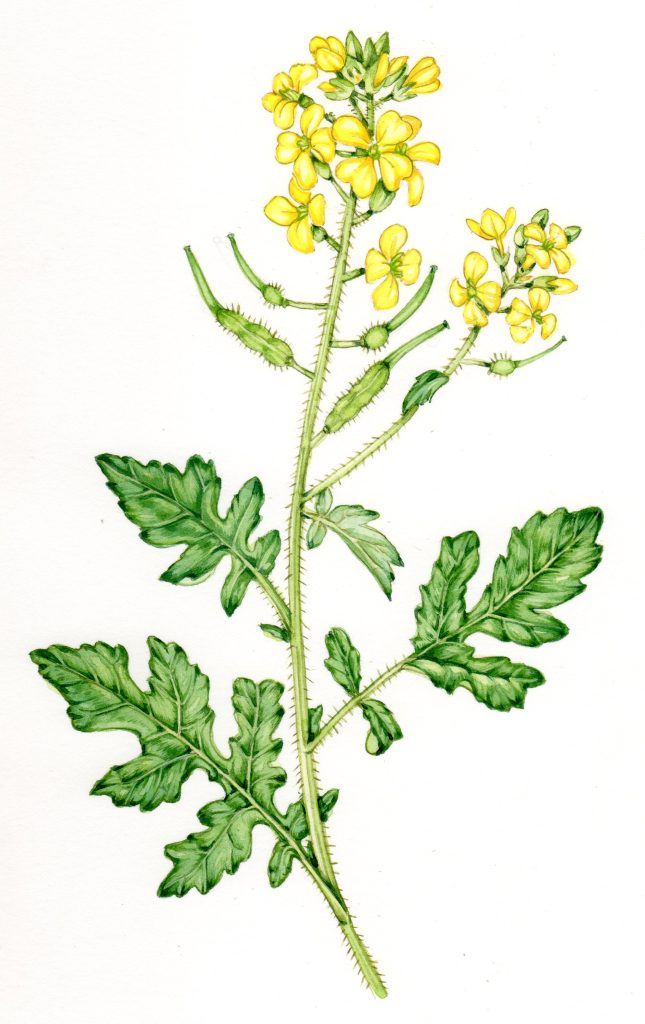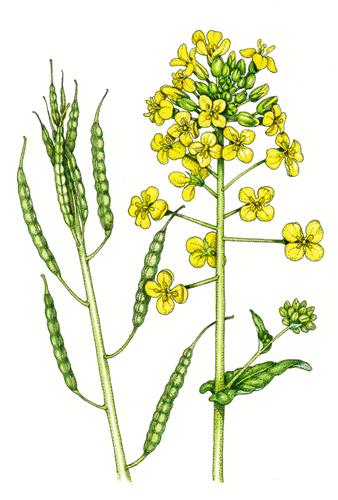Wildflower families: Brassicaceae, the Cabbage family

Wildflower families: Brassicaceae, the Cabbage family is another blog I’m writing in a series on wildflower families, inspired by my online Field Studies Council course. Adding botanical knowledge of flower families to my observations of plants helps to increase the accuracy of my illustration work.

White mustard Sinapis alba
These blogs discuss some common wildflower families. To get the basics sorted, take a look at my blogs on the basics of botany, different fruit types, and how Latin names work and matter (What’s in a name 1 and part 2). Check out the other families I’ve researched, the Ranunulaceae (Buttercups) and Caryophyllaceae (Campions) and keep an eye out for more families over the coming months. You could also browse all my blogs on Botany: Telling species apart.
Although I know a bit about wildflowers, I am an amateur, and not a botanist. I’ll try to get stuff right, but if you see a mistake, please tell me.

Sketchbook study of Wallflower Erysimum cheiri
Wildflower families: Brassicaceae
The Cabbage family has 390 genera and over 3000 species globally. Flowers have a distinctive four-petalled cross shape, and leaves are varied but alternate. Seed pods, or siliques, are another marker of this group of wildflowers. As well as Cabbage, vegetables like Cauliflower and broccoli, and turnips; Brassicaceae include garden flowers like Stocks and Candytuft. Many wildflowers are in this family, including the mustards, and ubiquitous Shepherd’s purse.

Savoy cabbage Brassica oleracea var. sabauda
Brassicaceae overview
Plants in this family have alternate leaves, cross-shaped flowers with four petals, and tend to have seeds held in elongate or squat seed pods which split in any number of ways. The name Brassicaceae comes from the Latin for cabbage, Brassica. It’s interesting to note that the Welsh (and other Celtic languages) for cabbage is similar, Bresych, which probably predates Latin as the source.
This family used to be known as the Cruciferae, referring to the four-petalled flowers, like a cross or crucifix.

Garlic Mustard Alliaria petiolata
Brassicaceae Leaves
Brassica leaves are simple, with smooth edges. Some may be very deeply lobed, like the Watercress. (For more on simple versus compound leaves check out my blog) They do not have stipules. There can be a big difference between leaves at the base and higher up the stem of a plant, with lower leaves lobed and upper ones entire.

Watercress Nasturtium officinale
Brassicaceae Flowers
Brassicaceae flowers are in large clusters, and are yellow or white.
The bumpy bits of broccoli and cauliflower that we eat are, in fact, flower buds. Leave broccoli to grow, and it’ll produce a spike of yellow flowers (which are also edible).

Broccoli Brassica oleracea italica
Flowers are regular, with radial symmetry and that distinct four-petalled shape. They do not have bracts or bracteoles.
There are four free sepals and four free petals. Within, there are four stamens, two short ones on the outside and four longer ones in the centre of the flower. Unlike members of the Ranunculaceae family, anthers face inwards. Flowers are bisexual.

Oil seed rape flower Brassica napus
Two fused carpels form a superior ovary, which grows above the rest of the flowering structure. For more on this look at my blog on the ovary.
Brassicaceae Fruit
Seeds develop in one of two pods, both of which are dry and split at maturity. The shorter pods are called Siliculas (like Shepherd’s purse), the longer ones are referred to as Siliqua (like Mustard or Oil-seed rape). They may be flattened, or clearly show the round seeds inside. Some, like mustards, have long beaks. Some seeds, like those of Woad, aren’t in pods at all, but non-splitting pendulous winged fruit.

Oil seed rape flower Brassica napus with long beaked siliqua
When mature, they split from the bottom upwards. Sometimes this is a simple split, like the Wallflower and Honesty. Sometimes there’s a twist at dehiscence (as with Hoary whitlow grass) which pings the seeds far from the parent plant.
You can see the seeds within, attached to both sides of a papery partition wall (the replum). If the seeds attach parallel or perpendicular to the replum can help tell species apart.

Wallflower Erysimum cheiri siliqua
The seeds themselves have almost no endosperm, but a large oily embryo. Seed coats can be mucilaginous.
Brassicaceae: Other species
As well as the vegetables and crop plants we’ve discussed, Brassicaceae contains horse radish, Garlic mustard, and one of my favourite wildflowers, Lady’s smock or cuckoo-flower.

Orange-tip Anthocharis cardamines butterfly with Cuckoo-flower Cardamine pratensis
Conclusion
I hope this blog on the Brassicaceae wildflower family has been helpful. I plan to write more blogs in this series over the coming weeks and months. References include the FSC botany course, from Common Families of Flowering Plants by Michael Hickey & Clive King, and from Naturespot.

Sea radish Raphanus raphanistrum maritimus

